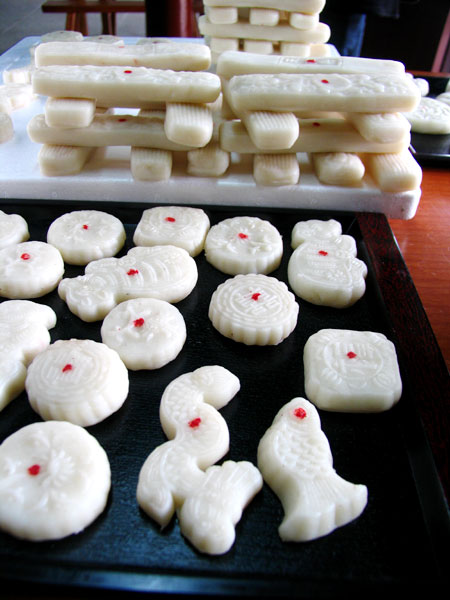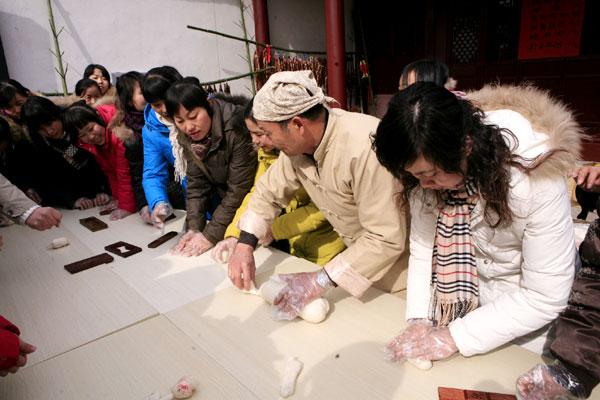Traditional treat
Updated: 2013-02-13 10:19
By Wu Yiyao (China Daily)
|
||||||||

 |
|
Residents in Ningbo, Zhejiang province, hand-squeeze the beaten rice paste before they use a mold to roll out traditional rice cakes in various sizes and shapes, as shown in the picture on the left. |
No matter how a piece of rice cake is fried, baked, toasted, steamed, stewed or grilled, the white glutinous ingredient must first undergo a process that may take up to three days.
Harvested rice is soaked in a huge water tank until it is soft enough to be milled without much effort. Water milling takes at least two people - one to grind, the other to add water to the ground rice until it becomes a milky paste that flows into a cotton-cloth bag. Squeezed rice paste is then put into a bowl in a wooden container and steamed.
As the milky paste turns pink and gradually becomes transparent, it becomes gaohua, "the blossom of cake".
"When I was a kid I often stole gaohua from the steamer as my parents did not notice, for me the gaohua is the essence of rice cake. It is sweet and juicy, which made it worth the pain of getting a beating if I was caught," said Liu Qishou, a 65-year-old resident in Cicheng in north Ningbo.
Liu has been making rice cake for six decades. Liu said steaming the gaohua is art of timing.
"If it is heated too long, it becomes too wet to be shaped, but if the heating time is too short, the sweetness cannot come out," said Liu.
After the steaming comes the beating. Again, it is two-person work, with one person pounding the gaohua with a wooden or stone hammer, while the other adds cold water to the hot paste and turns it.
"Physics and chemistry tell us the process changes the molecular structure of rice, which makes the rice easier to digest. In my eyes, the morale is that without a beating one does not become mature," said Liu An'guo, the 18-year-old grandson of Liu Qishou.
The beaten rice paste is then put on a chopping block, hand-squeezed into small balls, and kneaded into a roll. To get the traditional look of Ningbo rice cake, a mould is pressed onto the roll and red stamp pressed on the shaped cake.
"It is hard to tell how many recipes have developed over the centuries. I bet there must be thousands of them. One thing, however, is certain, rice cake is friendly to other ingredients. It is never too dominant or too compliant - it maintains the fragrance and taste of rice, but is open to other flavors," said Wu Qinfeng, a rice cake stall owner in Cicheng.
"My favorite recipe is easy, if not lazy: Just put sun-dried rice cake slices into burning charcoal until it expands like popcorn. The aroma and the color are irresistible", said Wu.











